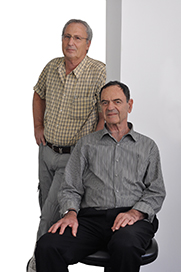Prof. Mati Friedkin from the Department of Organic Chemistry, and Prof. Yoram Shechter from the Department of Biological Chemistry at the Weizmann Institute of Science, won the "Inventors of the Year" award from the "Yade" company for 2009. The award was given to them for their significant contribution to expanding the effectiveness and bioavailability of protein-based drugs.

These drugs are actually divided into several types:
Proteins, peptides (short sequences of several amino acids), and derivatives of single amino acids. This is a very large group of drugs, used to treat a variety of diseases, including cancer, as well as to fight various harmful bacteria. The new technologies developed by Prof. Friedkin and Prof. Schechter arouse great interest in research laboratories and the pharmaceutical industry alike, mainly because the methods used today to administer such drugs are characterized by several shortcomings: they can only be given by injection; They are broken down in the bloodstream by enzymes that cut proteins; And small proteins are removed from the bloodstream in a short time by the kidneys. To get around the last two problems, it is customary to give many injections, which may cause another problem - overdose.
For decades, many scientists in different parts of the world tried to develop drugs that would bypass these difficulties. One approach designed to do this is based on connecting a chain or several chains of a synthetic polymer called "polyethylene glycol" to the drug. The substance protects the drug from breaking down enzymes, and also increases its weight, which prevents the kidneys from clearing it quickly, and prolongs the time it was in the bloodstream. However, until now, the method could only be used with a small number of small protein drugs, because in many cases the polyethylene glycol interferes with the activity of the protein, and sometimes even cancels its medicinal effect.
Prof. Friedkin and Prof. Shechter wanted to improve the effectiveness of the drugs, and prevent their toxicity. They managed to design a special type of protein which, as a result of a deliberate change, becomes inactive upon injection. After the injection, when it is already inside the body, the protein "awakens" to activity - and regains the ability to perform a medical operation. Injecting the protein in its inactive version also eliminates the toxicity problem. Prof. Friedkin: "It is a general method that can be used for any kind of small or large molecule, containing amine groups, with a short life span, which may be quickly cleared by the kidneys."
In the next step, the scientists combined the new principle they developed with the existing approach, of linking polyethylene glycol to protein, and obtained a new method: reversible linking of polyethylene glycol. The synthetic polymer is attached to the drug by a chemical bond that breaks down in the bloodstream. With the release of the polyethylene glycol, the inactive drug returns to its active state. Prof. Schechter: "The chemical bonds do not break down all at once, and thus the active protein is released in a slow, gradual and controlled manner. In this way, a particularly effective medical effect is obtained, and without the risk of overdose."
Protein drugs for the treatment of degenerative brain diseases - such as Alzheimer's and Parkinson's - are required to face another obstacle. Like a fortress, the brain is protected behind a barrier that "filters" the substances that are allowed to enter it from the bloodstream. Medicines - and especially medicines based on proteins - are unable to cross the barrier. On the other hand, several natural proteins have "passage permits" that allow them to pass through special "gates". Scientists tried to use these proteins as a "shuttle service" that would transport the drugs into the brain, but even in this case - linking the drugs to the carrier proteins caused the drugs to lose their effectiveness.
Prof. Friedkin and Prof. Shechter managed to overcome this problem as well by combining the approach they developed, of a reversible polyethylene-glycol link, with the use of leading proteins. In this way, they were able to transfer even non-penetrable drugs into the brain. In the brain, the drugs were released from the leading proteins, and as a result returned to their active state that allows them to perform medical activity.
The "Knowledge and Research and Development" company, which promotes industrial applications based on the inventions of Weizmann Institute of Science scientists, has already submitted applications to register several patents for the method. These days the company is in contact with a number of pharmaceutical companies that develop and manufacture protein-based medicines, which are interested in the possibilities of developing medical applications of the new method.

One response
Bravo